Granma 299
7.1 Earthquate shook California

Earthquake magnitude 7.1 shook California (+Videos)
According to the Euro-Mediterranean Seismological Center (EMSC), the epicenter of the tremor was located 16 kilometers west of Searles Valley, at a depth of 10 kilometers.
July 6, 2019 09:07:23
Author: Digital Editing | internet@granma.cu
A CubaNews translation.
Edited by Walter Lippmann.

A fire broke out behind a restaurant after the 7.1 earthquake that struck the Californian city of Ridgecrest. July 5, 2019. Photo: AP
An earthquake of magnitude 7.1 on the Richter scale shook Friday night in the U.S. state of California near the city of Ridgecrest, where another major earthquake occurred Thursday, according to RT.
The earthquake at 20:19 local time was reported as significantly greater than the July 4 earthquake, which had a magnitude of 6.4 and was recognized as the strongest tremor recorded in the region in two decades.
The latest news about last night’s earthquake indicated that it was 11 times stronger than the previous one.
According to seismologist Lucy Jones, as with any event of this type, the telluric movement has a chance of being followed by a larger tremor, as replicas of magnitudes five to six are likely.
Megan Person, spokeswoman for Kern County, reported that multiple injuries and fires have been reported in Ridgecrest, a community west of the Mojave Desert and approximately 240 kilometers north of the city of Los Angeles.
In the center of the latter city, Friday’s earthquake caused the buildings to sway strongly and felt more intense than the day before, while Donald Castle, who lives in Porterville, west of Ridgecrest, told the chain that his house was shaken from 20 to 25 seconds.
So far, the tremor was reported to have caused more than 15 aftershocks.
The San Bernardino Fire Department reported minor material damage caused by the natural disaster.
“Some houses have been displaced, cracks have appeared in the foundations, there are collapses of the retaining walls,” the service reported, detailing that fires were also recorded.
It is also known of the existence of slight injuries in the city of Ridgecrest, the closest to the epicenter, where the local Police Department has not received reports of serious injuries, according to the report.
A Rose Plucked by Betrayal


FROM THE LEFT
A Rose Plucked by Betrayal
The death of Rosa Luxemburg marked the final step of world social democracy towards treason; it was not only a crime committed with full consciousness of its historical significance, but orchestrated in function of a class hegemonism of the German bourgeoisie and big capital, allied after the defeat in the First World War.
Author: Mauricio Escuela | internet@granma.cu
A CubaNews translation.
Edited by Walter Lippmann.
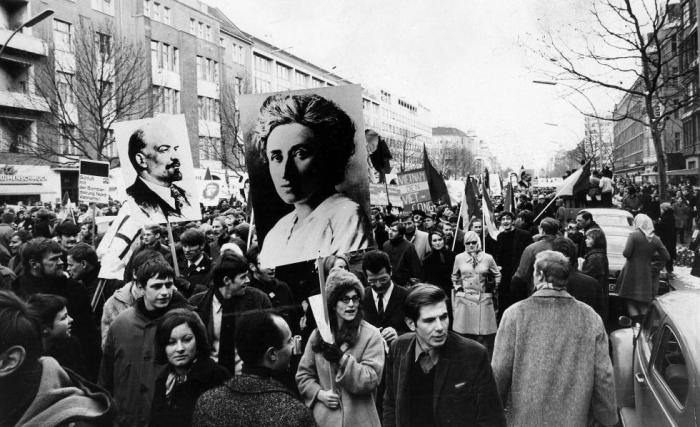
The Rose was plucked, but not hope. Photo: rosalux.org.ec
The death of Rosa Luxemburg marked the non-return of world social democracy towards treason; it was not only a crime committed with full consciousness of its historical significance, but orchestrated in function of a class hegemonism over the German working class by the bourgeoisie and big capital, allied after the defeat in World War I, to build a new right-wing order, the hard state of National Socialism (Nazi), which would lead Europe towards its dissolution as the center of the world.
In the cold dawn of January 15, 1919, Red Rosa wrote her last lines on the problem of the Revolution on the continent. And, although with pessimism, she referred to the hope that the masses would one day awaken from the nationalist and revenge lethargy hovering over the humiliated Germany of the time, and so the Revolution would show its true strength by saying: “I was, I am and I will be.”c
POLAND
Being born in a country occupied by Russians, Germans and Austrians made Rosa Luxemburg look at the national question with distrust. The most “revolutionary” she heard from many of the insurgents against foreign power was based on the restoration of the Polish feudal state of the 15th and 16th centuries, which represented in then Europe one of the puresy reminiscences of the landowner’s system of servitude. That political creature, impervious to the ideas of the French Revolution, was devoured by three modern and authoritarian states that contained the nascent germ of capital.
For Rosa, then, the national question was a setback and she based her appraisals on the need to internationalize the socialist and workers’ underground movement, as a way to quickly win the emancipation of the oppressed classes. Living later in Germany, a country that based its strength as capital on the unity built by Bismarck, convinced her that nationalisms only engendered steps backward on the road to a Revolution that, given the state of things at the end of the 19th century, seemed imminent.
In fact, in Germany the Social Democratic Party became the strongest and most numerous left party in the world, generating expectations in all revolutionaries. The very advance of this force in parliament provoked the removal of ultra-conservative and monarchical elements from the public sphere. But it also favored the establishment of pacts between that left and the central power of the State. It was the beginning of the historical betrayal of social democracy from Marxist socialism.
Rosa, who never felt Polish – much less German – encouraged this powerful left to extend eastwards, capturing countries under the aegis of old feudal empires, such as Russia. She saw in the mass movement of 1905 against the Tsar the beginning of the end of the crowned heads and the other European Caesars. However, the pragmatism of leaders and ideologues of social democracy, such as Karl Kautsky, would clash with Luxembourg’s theory of socialism as a new culture, whose idea is placed beyond nationalism.
For Kautsky, the struggle against capital was one of “attrition,” inasmuch as the strikes were only intended to move power momentarily, but never to bring about its downfall, and the young socialist movement “would not know what to do with the vacuum of authority.” But she saw in this what it was: an unprecedented concession to conservative power by the leadership of a party that was beginning to abandon its bases, while reviewing Marx’s thesis 11 on Feuerbach (Transforming the World). Historical facts demonstrated the lucidity of the Polish revolutionary, as opposed to Kautsky’s reformism, in heated and dangerous polemics.
THE SOCIAL DEMOCRATIC VOTE IN FAVOR OF THE EMPIRE
Many of those who, at the height of the 21st century, are surprised by the anti-popular cutback policies applied by the non-Marxist European left, forget that this betrayal began a long time ago. Perhaps it is not a bad memory, but a voluntary forgetfulness in order not to recognize the cynicism with which the revolutionary question has been handled since then by elements sold out to the interests of capital.
Marx warned that the original accumulation product of the plundering of the third world gave the European workers (a part of them) the possibility of becoming bourgeois and, therefore, defending interests far from total emancipation, guided only towards a nationalist, local question of selfish improvement of their living conditions. The European worker will thus support not only a conservative pseudo-socialism, but also the hard fascist who guarantees a middle-class standard of living, as we are seeing in today’s Europe.
That is exactly the explanation of German social democracy, the model on which that same continental tendency was built during the Cold War (1945-1991), as a wild card against the Marxist socialism of Eastern Europe.
Social democracy should not surprise us, because since the beginning of the First World War, the budget for the Army was approved in the German parliament, the same that would kill workers and peasants of the other rival imperialist nations of Europe. That fact marked Rosa Luxemburg’s distance when she founded the Spartacus League, the germ of the German Communist Party, which would be hated by social democrats, ultranationalists and monarchists alike.
The German failure in the trenches, which showed the impossibility of the “confluence” project. It put the country on the verge of a total civil war, with revolutionary forces ready to drive for power. However, years of social-democratic government and conservative trade unions that agreed with the existing powers prevented the necessary unity of action.
A poster placed in every corner of Berlin appealed, in those hungry early morning hours of December 1918: “Whoever wants bread, let him bring the head of Rosa Luxemburg”. The black legend of Nazism began by blaming the revolutionary socialists for national disaster, as it would later do with the Jews. Worst of all, this poster was sent to hang by the president of the Republic and leader of the social democratic party, Rosa’s former comrade.
Days later, a group of Freikcorps (antecedents of the Nazi SS assault troops) advanced on a lonely 47-year-old woman, who had her skull slashed with rifle butts, and then threw her blood-dripping body into a Berlin canal. A Spartacist comrade sent an obituary to Lenin, leader of Bolshevik Russia, saying that she “took her revolutionary condition to the extreme.
The Rose was uprooted, but not hope, much less History.
Correa Protests Facebook Cancellation

Correa Denounces Facebook Closing of His Page
Rafael Correa, former Ecuadorian president, alerted in his official Twitter account about the closing of his Facebook page.
Author: Digital Editor | internet@granma.cu
June 8, 2019, 11:06:31
A CubaNews translation.
Edited by Walter Lippmann.
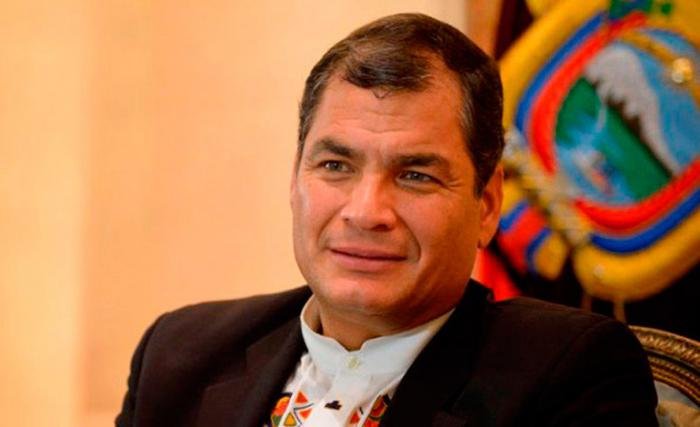
The former Ecuadorian president commented that the maneuver is a case of “open censorship”. Correa denounced that the Facebook company had closed his personal page in that social network, in which he was followed by 1.5 million people, due to a “political” decision.
In a message broadcast Friday on Twitter, the former Ecuadorian president (2007-2017) said that, according to Telesur, “we are witnessing a new attack on freedom of expression. Without any reason, the social network @NotiFacebook decided to suspend my account. Stronger than ever. We will continue fighting to recover our homeland.

Correa said Mark Zuckerberg’s company never warned him of “non-compliance with community rules,” and said the suspension was politically motivated.
The page of the former president, who is in Belgium after politically breaking with his former ally and current head of state of Ecuador, Lenín Moreno, was deactivated on April 11, the same day that Moreno’s government decided to withdraw political asylum from the founder of WikiLeaks Julian Assange.
Correa blamed this situation on the Facebook person in charge of the Andean Region, Diego Bassante, who would have political differences with the ex-president. “He was a judge and a party in this ‘technical’ decision to suspend the page,” he said.
The former president opened last Thursday a new page on the social network, which was joined by more than 40,000 followers in just a few hours. However, the account was canceled on Friday.
“I can’t believe it,” Correa said, and asked the lawyers to help him find out what can be done in these “open censorship” cases.
Publication Restricted 150 years

Publication Restricted 150 years
The French Secret File of the
CIA Attack on “La Coubre”
Facimile by Walter Lippmann, June 2, 2019.
Havana. March 7, 2011
by Jean-Guy Allard
• THE complete file of the investigation of the French CGT shipping company into the sabotage of the La Coubre vessel, responsibility for which is attributed to the CIA, is being held in the strongbox of a French maritime foundation, with a 150-year restriction on its release set by the legal counsel of the vessel’s last owners.
The file, whose existence was unknown until recently, lay for close to 50 years in the enormous collection of records belonging to the Compagnie Générale Transatlantique (CGT), also known as French Line, the owner of La Coubre when the tragedy struck in Havana on March 4, 1960.
In 1973, the CGT joined the Compagnie Générale Maritime, a state enterprise which was later privatized and handed over to a consortium currently known as CMA CGM. In 1995, the legal ownership and management of CGT’s archives was entrusted to a foundation whose 16-member executive included two CMA CGM representatives.
With the aim of conserving French maritime resources, this foundation, the Association French Lines, manages a historical research service for a number of shipping enterprises, in its headquarters located on Lucien Corbeaux Street in the port city of Le Havre.
Of the 30,000-plus files in the foundation’s archives, 79 contain references to La Coubre. One, numbered 22091, placed in the collection in 1997, has the following description: “La Coubre. Explosion in Havana, repairs, photographs, press articles, list of the missing persons, report to the executive committee, insurance terms, correspondence.”
The content of this file would seem to be of greatest interest, given its information on details of the act of terrorism in Havana that have never been made public. It came from the Legal Office of the defunct CGT and is marked “Classified,” with the surprising prohibition “PUBLICATION RESTRICTED 150 YEARS.”
The existence of such a dossier of information about La Coubre crime certainly constitutes one more mysterious element in the web of enigmas surrounding the most significant act of terrorism of the century in the Americas.
Dating back 51 years, on March 4, 1960, the sabotage of La Coubre to 100 deaths, among them six French members of the ship’s crew, more than 200 injured and many victims whose bodies were never found. The material damage was estimated then at approximately $17 million.
On many occasions, Cuba has charged the Central Intelligence Agency (CIA) with responsibility for the explosion aboard La Coubre in the port of Havana.
In the hours following the explosion, the Cuban leader Fidel Castro presided over a historic event in Plaza de la Revolución, in which he stated his conviction that the hand of the CIA, which had already shown itself highly aggressive toward Cuba, was behind the crime.
Named April 16, 1948 by the Canadian Vickers Ltd of Montreal, Canada shipyard, from October 11, 1951, La Coubre had been navigating between France, the French West Indies, Central America and the United States.
On August 22, 1960, La Coubre was towed from the port of by the Dutch ship Ooostzee to Rouen, France, where Chantiers de Normandie rebuilt the destroyed section. The ship went back into service April 1, 1961. La Coubre was successively renamed Barbara, Notios Hellas, and Agia Marina before finally being sold for scrap at the end of 1979 to a Spanish enterprise in Gandia (Valencia), which demolished it.
More than 50 years later, the U.S. government is still refusing to turn over documents related to La Coubrefrom its secret archives.
“It is not possible to have ignored circumstances in which a number of U.S. nationals were involved,” affirms Dr. José Luis Méndez Méndez, an eminent historian of terrorism against Cuba, citing a long list of suspicious elements linking the United States to the events.
“This crime had to have been officially investigated,” he stated.
The 22 French survivors of La Coubre were later repatriated by ship. Six French seamen lost their lives in the criminal explosion. First Lieutenant François Artola, pilot Jean Buron and sailors Lucien Aloi, André Picard, Jean Gendron and Alain Moura died, victims of this cynical act of aggression. •
Translated by Granma International
SOURCE: http://web.archive.org/web/20120202074059/http://www.granma.cu/ingles/cuba-i/7marz-LaCoubre.html
Ho Chi Minh’s Greatest Wish

FROM THE LEFT
What was Ho Chi Minh’s Greatest Wish
for His Party and His People?
Half a century ago, Ho Chi Minh wrote this political testament, which Granma reproduces not only for its validity, but also as a tribute to the leader of a brotherly people who was born on May 19, 1890.
—————————————————————————————————————————————
Author: Ho Chi Minh | kicedre@gmail.com
May 19, 2019 22:05:36
A CubaNews translation.
Edited by Walter Lippmann.
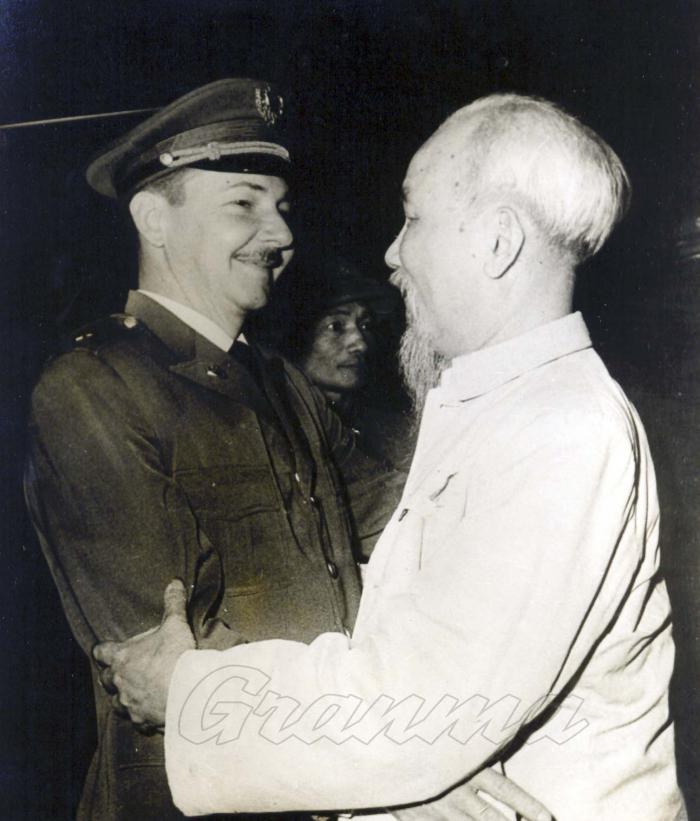
Army General Raul Castro was able to embrace Ho Chi Minh during his visit to Vietnam in 1966. Photo: Granma Archive
Although the struggle of our people against US aggression, for national salvation, must face more difficulties and sacrifices, we are determined to obtain total victory. That is for sure.
I intend, when that happens, to travel both North and South to congratulate our heroic peasants, military cadres and combatants, and to visit the elderly and our beloved children and youth. Then, on behalf of our people, I will go to the fraternal countries of the socialist camp and friendly countries all over the world, to thank them for their heartfelt support and the help they gave to the patriotic struggle of our people against U.S. aggression.
Tu Fu, the famous poet of the Tang period in China, wrote: “In all eras, few are those who reach seventy years of age. This year, since I am seventy-nine, I can count myself among those “few”; however, my mind remains perfectly lucid, although my health has declined a little compared to the last few years.
When one has seen more than seventy springs, health deteriorates with age. But who can say how much longer I will be able to serve the revolution, the Fatherland and the people? Therefore, I leave these lines in anticipation of the day when I must meet with Karl Marx, V.I. Lenin and other revolutionary leaders; in this way, our people throughout the country, our comrades in the Party, and our friends in the world will not be taken by surprise.
First I will talk about the Party: Thanks to its close unity and total dedication to the working class, the people and the Fatherland, our Party has been able, since its foundation, to unite, organize and lead our people from success to success in a firm struggle.
Unity is an extremely precious tradition of our Party and the people. All comrades, from the Central Committee to the cells, must preserve the unity and union of thought in the Party as the apple of their eye.
Within the Party, establishing a broad democracy and practicing self-criticism and criticism regularly and seriously is the best way to consolidate and develop solidarity and unity. Affection and comradeship must prevail.
Ours is a party in power. Every Party member, every cadre, must be deeply imbued with revolutionary morality, and demonstrate industriousness, frugality, integrity, probity, total dedication to the public interest and complete altruism. Our Party must preserve absolute purity and prove itself worthy of its role as the leader and loyal servant of the people.
The members of the Young Workers League and our youth, in general, are good; they are always ready to offer themselves, without fear of difficulties, eager for progress. The Party must promote their revolutionary virtues and train them to be our successors, both “red” and “expert”, in the construction of socialism.
The training and education of future generations of revolutionaries is of great importance and necessity. Our workers, on the plains and in the mountains, from generation to generation, have resisted hardship, feudal and colonial oppression and exploitation; they have also experienced many years of war. But our people have shown great heroism, courage, enthusiasm, and industry. They have always followed the Party since it saw the light, with unconditional loyalty.
The Party must carry out effective plans for economic and cultural development, in order to constantly improve the lives of our people. The war of resistance against U.S. aggression can be prolonged.
Our people can face new human and material sacrifices. No matter what happens, we must maintain our resolve to fight the U.S. aggressors to total victory. Our mountains will always exist, our rivers will always exist, our people will always exist, with the American invaders defeated, we will rebuild our land to make it ten times more beautiful.
In spite of the difficulties and setbacks, our people are certain that they will obtain total victory. The U.S. imperialists will certainly have to resign. Our Homeland will certainly be unified. Our compatriots in the South and in the North will certainly be reunited under the same sky. We, who are a small nation, will have won the honorable medal of having defeated, through heroic struggle, two great imperialisms – French and American – and of having made a valuable contribution to the world national liberation movement.
With regard to the world communist movement: As a man who has devoted his whole life to revolution, I feel more proud of the growth of international communism and workers’ movements, and I feel more hurt by the current discord between the brother parties.
I hope that our Party will do its best to contribute effectively to the restoration of unity among the Brother Parties on the basis of Marxism-Leninism and proletarian internationalism, in a way that suits both reason and feeling. I strongly trust that the brother Parties and countries will have to unite again.
Regarding personal affairs: all my life I have served my country, the revolution and the people with all my strength and with all my heart. If I must now depart from this world, I have nothing to regret except not being able to serve more and better. When I am gone, an onerous funeral should be avoided, so as not to waste the time and money of the people.
Finally: to all the people, to all the Party, to all the army, to my nephews and nieces, to the youth and children, I leave you my unlimited love. I also extend my cordial greetings to our comrades and friends, and to the youth and children all over the world.
My greatest wish is that our Party and our people, uniting their efforts closely, will build a peaceful, reunified, independent, democratic and prosperous Vietnam, and that they will make a valuable contribution to the world revolution.
12th Days Against Homophobia in Camagüey

Educate, together, the sense of freedom
The twelfth Cuban Days against homophobia and transphobia took place in Camagüey.
Author: Miguel Febles Hernández | febles@granma.cuMay 16, 2019 19:05:11
Translated and edited by Walter Lippmann for CubaNews.

Photo: Miguel Febles Hernández
CAMAGÜEY. – For those who insist on the siege, intolerance and excessive attack against everything that smells of Revolution, Mariela Castro Espín has the exact answer: the irreverent and “undisciplined” who star in this marvelous revolutionary experience do not allow themselves to be dominated by anyone.
In a meeting with professors and students from the Carlos J. Finlay University of Medical Sciences in this province, the director of the National Center for Sexual Education (Cenesex) referred to the challenges facing the Cuban people today in the face of the intensification of the aggressive policy of U.S. imperialism.
She placed special emphasis on the media campaign orchestrated in recent times by external and internal enemies to discredit the reality of the Cuban Revolution, its dreams, goals and desires, and the marvelous quality of this people, united by values and by an emancipatory historical project.
Faced with so much hostility, attempts at manipulation and bad intentions that only try to confuse, dismantle processes and put an end to the Revolution, the deputy to the National Assembly of People’s Power called to counterpose to it the intelligence, sensitivity, and commitment of the true patriots.
In that first battlefront, Cenesex is marching today, as an institution of the Cuban State in charge of advising on the definition of policies related to the defense of sexual rights, through comprehensive sexuality education and health promotion.

Photo: Miguel Febles Hernández
Together with an enthusiastic team of specialists and activists, she also carries out active research, organizing educational and community programs, and carrying out educational campaigns, such as the one she has been promoting for twelve years in the country against homophobia and transphobia.
“That is what we fight against: everything that generates discrimination, inequalities and inequities to humiliate, exclude and take away rights and opportunities,” said Mariela Castro Espín, referring to the essence of the work of the institution she directs, which she rightly called: educate in the sense of freedom.
The twelfth edition of the Cuban Days Against Homophobia and Transphobia, based in this city, has been a step forward in the effort to make the motto that presides over it a reality: All rights for all people, knowing that, along with the necessary legal changes, a profound process of cultural transformation must also take place.
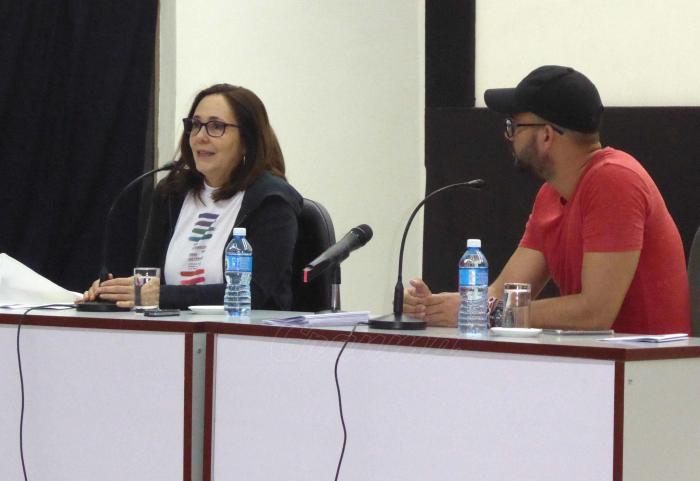
Photo: Miguel Febles Hernández

Photo: Miguel Febles Hernández
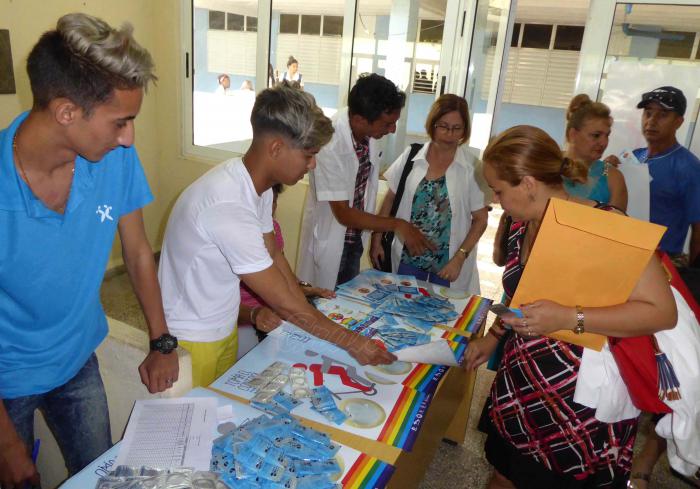
Photo: Miguel Febles Hernández
Beijing’s Hidden Side

Beijing’s Hidden Side
Beijing surprises at first sight, but it is essential to descend from the skyscrapers to the catacombs of the Chinese ancestors to understand why in this city, located from the Havana prism on the hidden face of the moon, even the humblest of its inhabitants speaks with optimism of the future.
by Alejandra García Elizalde, special report
A CubaNews translation. Edited by Walter Lippmann.

Photo: Taken from the Internet
Beijing looks like the city of the future. The first lights of the day on this side of the world – which lives 12 hours ahead of the Island – first stumble upon the skyscrapers of the city. In days of little pollution, it is a spectacle of yellow lights reflected in the crystals of the jungle of buildings that appears in front of the window of any neighbor of the Chaoyang district, located in the heart of the capital of the most populous country in the world.
Amidst the vertigo of architecture, there is space to remember Havana. Every morning, as on the Island, the parks are filled with people of all ages, taking advantage of the sun on cold days, or the cool in the heat; to walk their pets, play cards, buy fruit or sweets from street vendors who settle in the surroundings, or exercise with traditional Tai Chi, the martial art that many Cubans practice today, mainly in old age.
Although there are similarities between the Island and Beijing, the colors of the Caribbean and the smell of the sea are much missed. The tones of this city are mostly gray. The smoke caused by the pollution of nearby industries means that only a few times, after the dawn, one sees the blue of the sky or the sun.
It seems that the city floats within a thick cloud.
But Beijing attracts in other ways: the subway, always punctual, that connects in a few minutes each end of the city of more than 24 million inhabitants -more than twice as many as in all of Cuba-; the smells and flavors and variety of its food, despite being so different from that of Cuban cuisine; the way in which the skyscrapers coexist with the pagodas of imperial times, 5,000 years ago, a pattern that follows with certain fidelity the architecture of Havana’s Chinatown, on the backs of the Capitolio.
The hard-working and noble spirit of its people caught Fidel’s attention in 1995 and 24 years later, these traits remain intact. They are always seen in some activity: on scaffolding, watering trees on equipment prepared for it, when there has been much lack of rain, loading cement in the vicinity of a building under construction…
“I can appreciate that China is the country of the 21st century, it is the country of the future, with its human potential, its natural resources, scientists, the talent of its children. I believe that in the 21st century China is going to be the awakening giant,” Fidel told the press on that occasion. And so it has been.
Nothing is as important to the Chinese people as their history and millennial traditions; and the Qingming Festival or Day of Sweeping the Tombs, held every April 5, is proof of that. This national holiday is very reminiscent of the Day of the Dead in Mexico. Millions of Chinese visit the country’s cemeteries to pay tribute to their ancestors.
On that day they clean the tombs and adorn them with flowers, make offerings of food or money with fictitious bills created for the occasion that are burned next to the tombs to reach the beyond. The legendary hero and the humblest ancestor of a family matter.
Babaoshang, an ancient temple transformed into a cemetery after the Empire became a Republic west of Beijing, overflowed with flowers that day. There is such variety and color in the parade that tulips, peonies, orchids and chrysanthemums seem to come out of a painter’s palette. The country of the future is also a nation that does not forget, and this is perhaps the key, the yin and yang of Chinese power.
If 5,000 years ago his people discovered the compass, paper, silk, porcelain…, today it follows in the wake of another important transformation. In a quarter of a century, it became the second [largest] economy of the planet and is a reference for the world in the development of artificial intelligence, space exploration, the invention of initiatives to curb pollution of the environment.
Beijing surprises at first sight, but it is essential to descend from the skyscrapers to the catacombs of the Chinese ancestors to understand why in this city, located from the Havana prism on the dark side of the moon, even the humblest of its inhabitants speaks with optimism of the future.
Agnes Varda’s Cuban Memory

Agnes Varda’s Cuban Memory
From April 29 to June 10, a hundred images of Agnes Varda can be seen by Cubans at the National Museum of Fine Arts in an exhibition that accompanies the 20th French Film Festival in Cuba. French Film Festival in Cuba
Author: Pedro de la Hoz | pedro@granma.cu
April 26, 2017 21:04:16
A CubaNews translation.
Edited by Walter Lippmann.

Benny Moré captured by Agnes Varda.
Agnes Varda arrived in Havana in the last weeks of 1962. She did not shrink from the recent events that had kept the world on edge, with the Island at the center of one of the most critical episodes of the Cold War, the missile crisis and the danger of nuclear war.
Shortly before, she married Jacques Demy, in his second marriage. He was two years away from becoming a famous filmmaker with the musical The Umbrellas of Cherbourg. She, of Belgian origin but French by adoption, had debuted on the big screen with the film La Pointe Courte in 1954, which dealt with the relationships of a couple in a fishing village from which she took the name of the work, and appeared as one of the most disturbing personalities of the so-called nouvelle vague (new wave) since the 1961 release of Cleo de 5 a 7, a sensitive reflection on the boundaries between life and death.
Since she traveled without a film crew, Varda chose to record reality with a small Leica camera and ordinary black-and-white film. She wanted to know what was happening in the streets of the city, among people she loved, laughed, danced, and did not stop to philosophize amid challenges and tensions arising from a revolution threatened by a powerful neighbor.
She was not an improvised photographer. In the early 1950s, after studying Art History, she worked as such for none other than the National Popular Theatre of Paris, directed by Jean Vilar.
But the idea of portraying Cubans did not mean for her to return to the field of photography, but to use the images in a film. In February 1963, she revealed her purpose in an interview published in La Gaceta de la Unión de Escritores y Artistas de Cuba: “I’ve been struck by how much people move and how they move, and I want to give you an idea about that. But I am going to express it with an opposite procedure: by means of fixed photos, which I will then animate based on the intermediate movements. Thus was born Saludos, cubanos (Salut les Cubains), which premiered in 1964.
In the winter of 2015, the Centre Georges Pompidou in Paris asked the mythical filmmaker – at that time she was revered for La felicidad (1965), Daguerrotipos (1975), Sin techo ni ley (1985, winner of the Golden Lion at the Venice Film Festival) and Jacquot de Nantes (1991) and had just become the first woman to be awarded the Palme d’Honneur in Cannes – to collect the Havana photos for the first time.
She thought that the curatorship would opt for other images, for example, according to her words “a portrait of Salvador Dalí, another of Eugene Ionesco or things from the Europe of the 50s and 60s, considering that Cuban photographs were never conceived to be exhibited”.
Varda/Cuba was a rediscovery. There were Fidel Castro, smiling despite the fact that when the photographer found him she asked him not to smile; those who had learned to read from the 1961 national literacy campaign who later decided to train as teachers, cane cutter volunteers, teenage loves, and children’s games.
That’s where the great Benny Moré appeared, with his unbeatable singer’s stamp even when he knew he had been wounded to death, and a very young Sara Gómez, dancing a cha cha chá dressed as a militia member for the days when she dreamed of being the first Cuban filmmaker.
From Saturday, April 29 to June 10, Cubans can see a hundred of Varda’s images. The National Museum of Fine Arts will display them in an exhibition that accompanies the 20th French Film Festival in Cuba.
Some will succumb to nostalgia. Others will not, because they will see in that graphic testimony, more than an unrepeatable moment, the trace of what was carved in time, of a resistant spirit.
http://www.granma.cu/cultura/2017-04-26/memoria-cubana-de-agnes-varda-26-04-2017-21-04-16
++++++++++++++++++++++++++++++
Published on Jan 28, 2016
++++++++++++++++++++++++++++++
Agnes Varda’s Benny More video.
The eight years of “spring”

The eight years of “spring”
Libya is a very clear exponent of what U.S. military intervention has left the world.
————————————————————————————
Author: Ana Laura Palomino García | internet@granma.cu
A CubaNews translation.
Edited by Walter Lippmann.
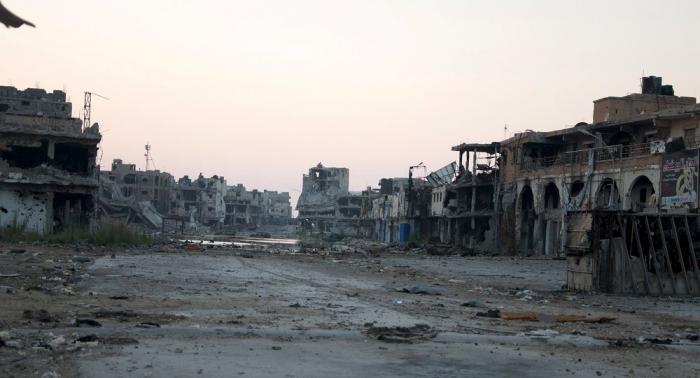
Libya devastated by endless conflict. Photo: Sputnik
In 2011, the Middle East underwent a reconfiguration of its political map through protests stimulated from outside, and interventions disguised as aid. This series of events went down in history as the “Arab Spring”. However, the similarity with the word that refers to one of the most festive seasons of the year is only in nomenclature, as this geographical region has since been plagued by continuous internal crises, resulting in a climate of permanent instability.
In this situation lives Libya, a nation that for four decades had traveled paths of stability and progress under the hand of President Muammar Gaddafi, a leader who promoted social and economic development in this North African country.
What happened? An accurate formula of manipulation, lies and “humanitarian intervention” designed by the US government and supported by the European Union (EU) was applied against Libya, which sounds suspiciously familiar to the situation facing the Venezuelan people today.
The opposition forces were armed to fight Libya’s army, a conflict was constructed in the media that, it is known, had as real scenario of development film and television studios, hired extras, stuffing extras, where battles, massacres, bombardments were filmed, in the best style of Hollywood cinema. Through this, they manufactured the necessary pretext that “justified” the intervention of the US-NATO duo, under the pretext of “preserving human lives”.
Invented bloggers emerged, supposedly writing from Tripoli about events in real time, but months after the end of the staging it became known that the vast majority of that “citizen journalism” was made thousands of miles away from Libyan land, from comfortable offices in London, New York or Berlin.
In order to sow chaos, the international mass media carried out a “mythification” of the Libyan president, spreading the story that he was governing through blackmail and humiliation.
This false image, paved with fake news about the execution of civilians in the confrontation between the army of Gaddafi and the militias, was amplified by the large newspapers and right-wing publications, which gave them greater validation.
All these lies responded to the simple reason that in this country there are the largest reserves of light oil in Africa and the Western oil companies wanted to take them. Also, months before, Gaddafi had urged African and Muslim countries to adopt a single currency: the gold dinar. In that way, the dollar would have been excluded, threatening the empire’s currencies.
But the truth had nothing to do with this story. The media montage combined with the actions of the US and NATO bombings not only ended the life of the Libyan leader, but also turned that nation into the failed state that it still is today.
FORTY YEARS OF PEACE
Libya was an Italian colony until the Second World War when, by agreement of powers such as Britain and France, and the United Nations, it was administered by both countries. The British ruled the destinies of the regions of Cyrenaica and Tripolitania, and the French occupied the area of El Pezzan, until 1951 when the nation achieved its independence.
However, until 1969, when Gaddafi overthrew the monarchy of King Idris, the people of that country lived in difficult conditions. They had low rates of development, as exemplified by an article entitled “Libya according to the UN and the harsh reality,” by Thierry Meyssan, a French journalist and political activist, which states, among other elements, that only 250,000 inhabitants of the 4 million total knew how to read and write.
With independence and the subsequent construction of a state characterized by social achievements, Libya reached one of the highest indices of human development and the highest nominal per capita GDP in Africa.
Several sources say that Gaddafi led his country to set an example for Africa and the Arab world by unifying the nation and creating institutions and ministries to strengthen institutionality.
The movement promoted by Gaddafi was known as “The Green Revolution”.Among its achievements were the beginning of an agrarian reform, the impulse of a social security system, putting health within the reach of all and that the profits of resources such as oil, could be really exploited by the people.
In order to achieve this objective, the Libyan government nationalized the so-called black gold industry, taking those large incomes to subsidize minimum human rights such as access to drinking water or education, which before were considered true luxuries.
The Libyan leader allowed peasants who wanted to till their own land to do so and the state helped them to do so. It also promoted housing as a right for all as well as access to electricity.
According to Telesur, loans of any kind had a zero percent interest rate and the Central Bank of Libya was a sovereign institution at the service of citizens.
Gaddafi worked for the cooperation of African countries through the African Union (AU), founded in May 2001, with the aim of finding a way to empower these countries without the intervention of Western powers.
FAREWELL TO DEMOCRACY
El País, a well-known Spanish newspaper, included in many articles the vision of a Gaddafi obsessed with power and sex. However, in 2016, five years after his physical disappearance, they had to accept and publish that Libya was living a real nightmare, where the people were the least.
An example of this is political instability. Today, Libya has up to three governments, two in the capital, competing for leadership in the west of the country, and another in Tobruk, which dominates the eastern regions and controls the main oil resources.
On the other hand, Usef Shakir, an expert on the subject, comments for Sputnik that “Libya used to be secure and stable: the state worked well, the country was developing. Years later the country is in chaos and terror. Some of its cities are still under the control of armed groups. We can deduce that Libya has degenerated from a sovereign country to a mixture of fragmented groupings.
It should be noted that since 2011 more than 5,000 people have lost their lives and almost one million have fled their homes because of fear and insecurity. Also, crude oil exports have fallen by 90% and the losses of its GDP are accounted for around 200 billion euros over the last eight years, according to figures collected by Middle East Monitor.
Women’s rights, respected during the former president’s government, are outraged without the slightest remorse. According to Amnesty International’s official website, “the ongoing conflict is particularly damaging to women, disproportionately affecting their right to freedom of movement and to participate in political and public life”.
Libya is a very clear example of what US military intervention has left the world: chaos, political instability, appropriation of resources by Western transnationals and an “oasis” where terrorist groups, local militias and others converge, in addition to being an example of human trafficking and extortion to those who arrive there in search of a quick way to Europe through the Mediterranean.
IN CONTEXT:
In January 2011 several Middle Eastern countries were shaken by revolts, uprisings, protests and covert interventions that resulted in a reconfiguration of the map of the region. These events were referred to by the West as the “Arab Spring”.
It began with the so-called Tunisian revolution, whose starting date is usually counted from the immolation of Mohamed Bouazizi, a 26-year-old young man who protested against the police, on 4 January 2011.
Behind all these uprisings soon became visible the hand of Western powers, as always, with the U.S. and France, among other countries at the forefront.
An external intelligence report, quoted by French journalist and intellectual Thierry Meyssan, said that on February 4, 2011 NATO organised in Cairo a meeting to launch the “Arab Spring” in Libya and Syria. According to the report, John McCain chaired the meeting.
SOURCE: TELESUR
New Technologies and Mental Health

Cuban Psychiatry Studies the Impact of Technologies on Mental Health
When Cuban society advances towards computerization as a priority, it turns out, in the opinion of Dr. Miriam de la Osa O´Reilly, head of the Psychiatry Service of the Hermanos Ameijeiras clinical-surgical hospital, that the theme chosen for the IX Cuban Congress of this specialty is very timely: Frontiers of Psychiatry and the Impact of New Technologies.
Author: Lisandra Fariñas Acosta | lisandra@granma.cu
14 March 2019 00:03:09
Translated and edited by Walter Lippmann for CubaNews.
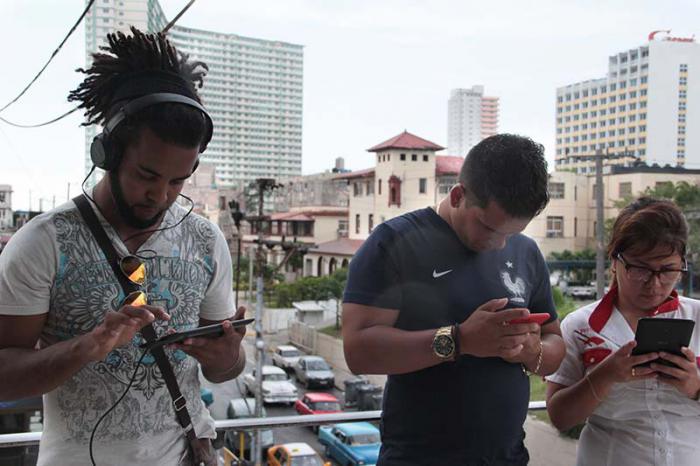
Photo: Yaimi Ravelo
In the danger of living an excessively “connected” 21st century, and increasingly dependent on computers or cell phones, psychiatry finds new and enormous challenges, said Dr. Miriam de la Osa O´Reilly, head of the Psychiatry Service of the Hermanos Ameijeiras clinical-surgical hospital, to Granma during the first day of the 9th Cuban Congress on this specialty.
We are talking about behavioral addictions, which can range from distorting reality, showing dependence on devices to having communication and socialization problems, and even suicidal attitudes, all related to the misuse of mobile phones and different social networks on the Internet.
When Cuban society moves towards computerization as a priority, in the opinion of the specialist, the topic chosen for the appointment is very topical: Frontiers of Psychiatry and the Impact of New Technologies.
The congress, which seeks to be a space for reflection, scientific exchange and professional commitment, on a science that gains in maturity and experiences on the road to human improvement and well-being. It brings together more than 250 Cuban delegates and some twenty countries at the Havana Convention Center through Friday, March 15.
“We have tried to make the scientific program address the main problems of mental health in the population, while constituting an update on topics specific to this century. Among these are the advantages and dangers of using the Internet, but also the development of neurosciences and nanotechnology in psychiatry,” said the president of the organizing committee.
We communicate all the time, and there is a network like a highway, in which one can advance in time, distance, friends and knowledge is extraordinary. But that same goal implies, if not used properly, multiple dangers, she said.
That’s why psychiatry professionals insist, from the promotion of health and prevention of diseases, on being aware of the problems that so-called TICS can bring; an alert that involves the media and the rest of society, especially when Cuba connects more and more, insisted Dr. Osa O´Reilly.
Healthier contents should be placed in the social networks that are being created and in the existing ones. They should be directed to the well-being of people. At the same time, a critical reading of those messages that we consume daily is needed. And let’s not lose sight of what the smallest members of the household consume, she warned.
The young population is the most affected by this misuse, explained the specialist. And there are plenty of examples, ranging from nomophobia or fear of being without a mobile phone for a long time, the need to check it even when the person wakes up at dawn, to the controversial selfies, which have caused death in the search for new, exuberant places… and the construction of a virtual life in networks like Facebook, dissonant from reality and which can lead to depression.
The interviewee also mentioned other organic consequences of these addictions, such as vision disorders or orthopedic disorders, when adopting incorrect postures for a long time in front of a computer or mobile phone.
On the other hand, for Profesor de la Osa, in this technological era, the cornerstone of the specialty continues to be clinical training, she said.
Based in the capital, the 9th Cuban Congress of Psychiatry was extended in a group of pre-congress courses to the provinces of Artemisa, Santiago de Cuba and Holguín.
On the closing day this Friday, Doctor of Science Pastor Castell-Florit Serrate, director of the National School of Public Health of Cuba and president of the National Council of Scientific Health Societies, stressed that Cuba recognizes the complexity of mental health problems and their social determination, as well as the right of the population to it. In addition there’s to the provision of information and communication with patients and families, and to understanding and support until recovery and continuation of the life project.
Dr. Carmen Borrego, head of the Mental Health and Addictions section of the Ministry of Public Health, signified the high knowledge and responsibility of the professionals of this branch in Cuba, who work in a wide network of services in the country and exceed one thousand specialists.
Subscribe to Blog via Email
| M | T | W | T | F | S | S |
|---|---|---|---|---|---|---|
| 1 | 2 | 3 | 4 | 5 | 6 | 7 |
| 8 | 9 | 10 | 11 | 12 | 13 | 14 |
| 15 | 16 | 17 | 18 | 19 | 20 | 21 |
| 22 | 23 | 24 | 25 | 26 | 27 | 28 |
| 29 | 30 | 31 | ||||

You must be logged in to post a comment.